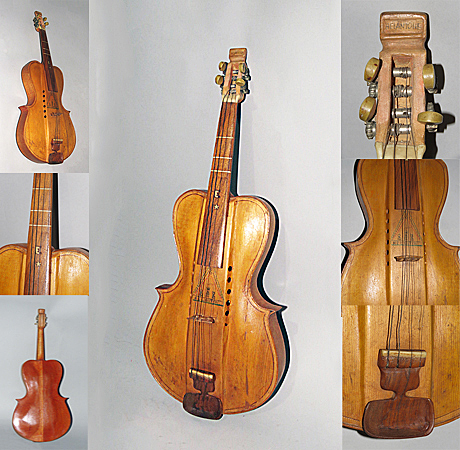
Owner: HWMC
Catalog#: 2CL-CHLT-143
Provenance: Fred Spector Collection, Chicago, Illinois
Violin Family
'Folk Fiddle' by Anton E. Saulirb (A)
Anthony, Florida
Anton E. Saulirb
Wood, bone, mother-of-pearl, pigment
May, 1962
Length: 22 in; Width: 8.75 in; Depth: 1.63 in; Body Length: 13.5 in
Strings – Lutes – Violin Family
Stamped inside: Made by / Anton E. Saulirb / Anthony, Florida U.S.A. / (Handwritten: May 1962)
Fiddles are violins, but over time and usage, some have been called folk fiddles with their slightly different shapes and playing styles.
This folk fiddle represents the self-taught folk instrument makers of today. It was made by Anton E. Saulirb, from Anthony, Florida U.S.A. in 1962. At the top of the peghead in place of a scroll is a rectangle framed block with an engraved name ‘HELANTONE’. The four ivory mechanical pegs face front wise in a front open peg box for tuning the four metal strings. There are three ivory/bone frets with “E” and a five-pointed star inlaid on the finger board. The face of the resonator body is inserted with a slight rim and there is engraving to represent purfling around the edge. Between the wooden finger board and ornate bridge with six holes on the top of the elevated resonator body is the drawing of a triple triangle. At the top of the triangle is drawn a candelabra with three candles. Within the drawn triangle are three figures and underneath is the word ‘HELANTON’. On each side of the elevated resonator body in the middle are six medium round resonator holes. The tailpiece is connected to the chin rest and consists of bone and a different type of wood. The back is made from two pieces and has no purfling.
The earliest home-made fiddle that still exists was made in 1759 by John Antes. As the nation continued to grow, so did the need for violins/fiddles. According to Johnson String Instrument, ‘the origins of violin making as it specifically evolved in this country, involved three types of makers: Self-taught folk instrument makers; Professional craftsperson from other trades who turned their skills toward instrument making; and European-trained makers who immigrated to this country.’
Folk fiddles were played by the colonists and immigrants who brought these rather small easily carried violins and their native music to America. At first, many of the folk musicians were immigrants from England, Ireland, Scotland, France, and Germany. Records show that among the first settlers in Jamestown in 1607, was John Utie, a planter by trade and a fiddler. As the nation grew, so did fiddling throughout the United States. Today, styles of fiddling include Bluegrass, Old-Time, Cajun, Blues, Western Swing, Country, and many others, each with its unique sound and techniques. These early fiddlers played for many activities including barn dances, weddings, wakes and just about every social function that required music.
Resource: https://fiddlehed.com/blog/america-fiddles-the-early-days/; https://www.johnsonstring.com/american-collection/
This fiddle came from the Fred Spector collection of Chicago (Lincoln Park), Illinois. Fred played violin with the Chicago Symphony Orchestra for 47 years.
